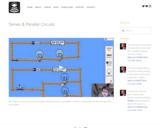
Mr. Andersen contrasts series and parallel electrical circuits. A simulation is used to visualize electron flow through both circuit types.
- Subject:
- Physical Science
- Physics
- Material Type:
- Lesson
- Provider:
- Bozeman Science
- Date Added:
- 05/29/2014

Mr. Andersen contrasts series and parallel electrical circuits. A simulation is used to visualize electron flow through both circuit types.
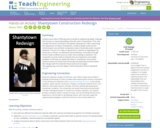
Students learn about STEM education through an engineering design challenge that focuses on improving building materials used in shantytowns. First, they consider the factors that lead to shantytown development. After researching the implications of living in shantytowns, students design, build and test cement-based concrete block composites made of discarded and/or recycled materials. The aim is to make a material that is resistant to degradation by chemicals or climate, can withstand natural disasters, and endure through human-made conditions (such as urban overcrowding or pollution). The composites must be made of materials that are inexpensive and readily available so that they are viable alternative in shantytown communities. Students assess the results both chemically and physically and then iterate their designs with the materials that proved to be strongest.

Equilibrium occurs when the overall state of a system is constant. Equilibrium can be static (nothing in the system is changing), or dynamic (little parts of the system are changing, but overall the state isn't changing). In my video, I'll demonstrate systems in both types of equilibrium, and how the equilibrium states can be shifted.

Students explore the basic physics behind walking, and the design and engineering of shoes to accommodate different gaits. They are introduced to pressure, force and impulse as they relate to shoes, walking and running. Students learn about the mechanics of walking, shoe design and common gait misalignments that often lead to injury.

Students use their understanding of projectile physics and fluid dynamics to find the water pressure in water guns. By measuring the range of the water jets, they are able to calculate the theoretical pressure. Students create graphs to analyze how the predicted pressure relates to the number of times they pump the water gun before shooting.

Student teams make polymers using ordinary household supplies (glue, borax, water). They experiment with the semi-solid material when warm and cold to see and feel its elastic and viscous properties. Students will begin to understand how the electrical forces between particles change as temperature or the force applied to the substance changes. Is it a solid, a liquid, or something in between? How might it be used?

Students build and use a very basic Coulter electric sensing zone particle counter to count an unknown number of particles in a sample of "paint" to determine if enough particles per ml of "paint" exist to meet a quality standard. In a lab experiment, student teams each build an apparatus and circuit, set up data acquisition equipment, make a salt-soap solution, test liquid flow in the apparatus, take data, and make graphs to count particles.
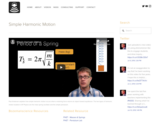
Paul Andersen explains how simple harmonic motion occurs when a restoring force returns an object toward equilibrium. The two types of harmonic motion studied in AP Physics are the mass spring oscillator and the simple pendulum.

The video resource "Simple Harmonic Motion: Crash Course Physics #16" is included in the "Sociology" course from the resources series of "Crash Course". Crash Course is a educational video series from John and Hank Green.
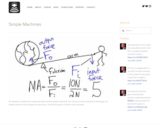
Mr. Andersen explains the simple principles behind simple machines. He shows how the mechanical advantage of a simple machine can increase the input force. A brief discussion of work is also included.
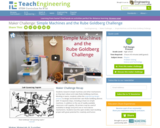
Students research simple machines and other mechanisms as they learn about and make Rube Goldberg machines. Working in teams, students design and build their own Rube Goldberg devices with 10 separate steps, including at least six simple machines. In addition to the use of readily available classroom craft supplies, 3D printers may be used (if available) to design and print one or more device mechanisms. Students love this open-ended, team-building project with great potential for creativity and humor.
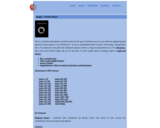
This is a calculus-based physics textbook meant for the type of freshman survey course taken by engineering and physical science majors, or for AP Physics C. It uses a nontraditional order of topics, with energy coming before force. For instructors who prefer the traditional sequence, there is a drop-in replacement for ch. 0-4, Mechanics, that covers force before energy. My text for the type of course usually taken by biology majors is Light and Matter.

In this activity, students are challenged to design a contraption using simple machines to move a circus elephant into a rail car. After students consider their audience and constraints, they work in groups to brainstorm ideas and select one concept to communicate to the class.
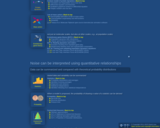
In a toy model of a cell, protein X is produced according to a translation rate coefficient and eliminated according to a degradation rate coefficient. The protein copy number at which the rates for these processes balance is called the steady-state level, and the time it takes for a cell initially containing zero copies of protein X to accumulate half the steady-state level is called the _ŃŇrise time._Ń Surprisingly, the "rise time" depends on the degradation rate coefficient only. The classic textbook presentation of this topic is found in Alon, An Introduction to Systems Biology: Design Principles of Biological Circuits, Boca Raton: Chapman & Hall/CRC, 2007 (p. 18-22).

Students examine collisions between two skateboards with different masses to learn about conservation of momentum in collisions.
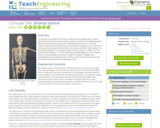
Through this unit, written for an honors anatomy and physiology class, students become familiar with the human skeletal system and answer the Challenge Question: When you get home from school, your mother grabs you, and you race to the hospital. Your grandmother fell and was rushed to the emergency room. The doctor tells your family your grandmother has a fractured hip, and she is referring her to an orthopedic specialist. The orthopedic doctor decides to perform a DEXA scan. The result show her BMD is -3.3. What would be a probable diagnosis to her condition? What are some possible causes of her condition? Should her daughter and granddaughter be worried about this condition, and if so, what are measures they could take to prevent this from happening to them?
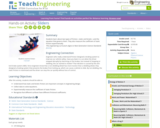
Students learn about two types of friction static and kinetic and the equation that governs them. They also measure the coefficient of static friction experimentally.
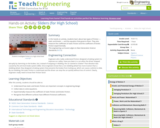
In this hands-on activity, students learn about two types of friction static and kinetic and the equation that governs them. They also measure the coefficient of static friction and the coefficient of kinetic friction experimentally.

Students use a spring scale to drag an object such as a ceramic coffee cup along a table top or the floor. The spring scale allows them to measure the frictional force that exists between the moving cup and the surface it slides on. By modifying the bottom surface of the cup, students find out what kinds of surfaces generate more or less friction.
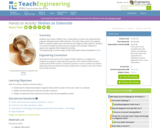
In this activity, students use an old fashion children's toy, a metal slinky, to mimic and understand the magnetic field generated in an MRI machine. The metal slinky mimics the magnetic field of a solenoid, which forms the basis for the magnet of the MRI machine. Students run current through the slinky and use computer and calculator software to explore the magnetic field created by the slinky.